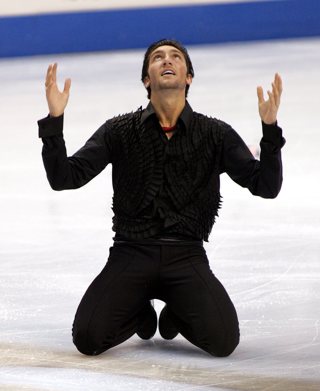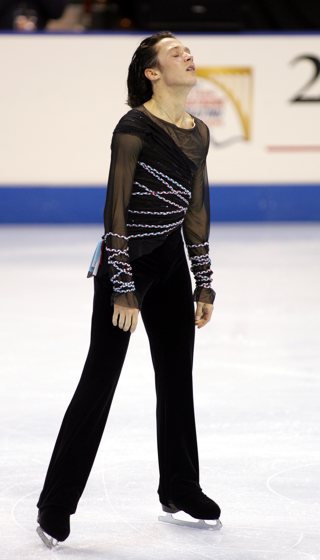2007 U.S. Figure Skating Championships
Spokane, Washington
21 - 28 January, 2007
Event ReportsNoviceNovice Ladies JuniorJunior Ladies Senior |
Daily NotesFor individual event reports follow the links at the left.Saturday, 27 JanuaryCompetition events finished today with the skating of the Men's and Ladies Free Skating. The Ladies began late in the morning, while the Men competed in the evening. Kimmie Meissner won her first National title, but with only a third place finish in the Free Skate, which was won by Alissa Czisny. In the Men's event Evan Lysacek crushed the competition, dethroning Johnny Weir, and winning his first National Title. The events were broadcast live, but with a 10 PM finish for the men, viewers on the east coast had to stay up until 1 AM to see the competition, a scheduling choice the men found disappointing.
With Czisny winning the Free Skate, but placing only third overall, the ladies event illustrates the sharp difference between the old method and the new method of combining event segments. With the old method (total factored place) there were examples of skaters moving up from a poor skate in the short to win an event; but rarely did a skater win the free skate and lose the event. Under the new method, skaters can move up from a poor result in the short to win, but equally often, a skater can win the long and lose the event, as was the case here. The top three ladies and top three men were named to the World team and Four Continents team. Friday, 26 JanuaryThe Junior events finished today with the Men's Free Skating skated late this morning. Later in the day the Senior Pairs and Senior Dance finals took place. Brooke Castile & Ben Okolski won their first National title, while Tanith Belbin & Benjamin Agosto took their fourth. Top three teams in Dance and Pairs will be going to Four Continents next month. Top two in Pairs and top 3 in Dance will be going to Worlds in March. Thursday, 25 JanuaryThe Junior Pairs event finished this morning with the skating of the long program. Keauna McLaughlin & Rockne Brubaker were the stand-out team of the event, wining both the Short Program and the Free Skate. The Senior Men's Short Program was skated in the afternoon, while the Ladies Short Program was held in the evening. Best of all, we got done by 9:30! The trend we noted in Program Components in the Pairs event continues in the Men's and Ladies events. We again find that the Program Component scores are systematically well bellow the element scores. The only Senior event where this is not true, where the Program Component scores are in line with the element scores the way they are supposed to be, is the Senior Dance. Last year, the judges gave grossly inflated Program Component scores in the first use of IJS at a U.S. Nationals. This year they seem to have overcompensated in the opposite direction. Wednesday, 24 JanuaryToday was the last day for events at the Convention Center, thank God. Not that there is anything terrible about the convention center. It is a decent space overall, and the few skaters asked have no issue with the quality of the tank ice, other than it is NHL size instead of Olympic size. But I am glad to no longer have to sit way up high in the widow-maker bleachers, and to get away from the lighting, which is dreadful from a photographers point of view. The Junior Men's Short Program took place late in the morning in the Convention Center. It was followed later in the afternoon under the big-top by the Junior Dance Free Dance, their only skate in the big arena. In the evening we had the Senior Pairs Short Program. Having just three events today was a blessing after three days of five-event days. There are six days of competition, but nearly 60% of the events are crammed into the first three days, so everyone working the entire competition is pretty tired going into day 4. Nationals press conferences are usually pretty tame. Hardball questions are infrequent, and the skaters rarely say anything extraordinary. But the press conference after the Senior Pairs Short Program was a doozy. After the usual how did you feel about your performance questions, John Baldwin was asked about the recent report of his being attacked in Russia after the Cup of Russia competition. He responded that he did not want that story to detract from focus on the competition. When pressed about the motivation behind the timing of the story becoming public, and the lack of any known documentation that the attack actually took place, he stood his ground, saying he would only discus it in private after the competition, though he insisted that the attack did take place but tacitly acknowledged there was no independent verification or documentation of the attack. Then he was asked about what the team needed to do to get on the podium at Worlds, and to comment on the state of the U.S. pairs program. Baldwin said that the U.S. program has improved in recent years, and was now the equal of any program in the world, except for the Chinese, whose teams "train under a communist system." He then launched into the old saw that the only reason the Chinese, or the Soviet skaters are/were successful is because they are/were forced to skate together under communism. When challenged, he did admit that teams such as Gordieva & Grinkov also had some talent, and that might have had something to do with their success too. When asked about more recent Russian skaters who have also been successful since the end of communism in Russia, he was nonplussed, and became combative. Eventually he responded that those skaters were a last remnant of the communist system. At the closing bell, we call this round a draw. Baldwin did not back down on any of his comments, and those asking the questions (which did not include me, so don't send me any cranky e-mail if you think Baldwin was being picked on by the mean media) were not satisfied with the answers. In all of this, Baldwin did make one point that is clearly true. He remarked that U.S. teams give up too quickly when they reach a rough spot, and go look for a quick fix by changing partners, or moving to another coach, or rink, etc., rather than trying to work through the rough times. Tuesday, 23 JanuaryWith the completion of the Novice events yesterday, the competition ramped up with more Junior events and the start of the Senior events. The Junior Dance Original Dance started off the day at the Convention Center, followed by the Junior Men Short Program. In the main Arena, the Senior dancers skated the Compulsory Dance in the afternoon, and the Original Dance in the evening. To round out the day, the Junior Ladies final took place in the main arena in the early evening. Another late finish too, with the awards for Junior Ladies not finishing until near 11PM. There were fairly decent crowds on hand today, especially considering these were mostly lower level events on a weekday. The Convention Center was filled, and the main arena perhaps half full. Mirai Naguasu won the Junior Ladies title. She was challenged by Caroline Zhang, but a falls in triple flip in the Free skate cost Zhang a victory. Tanith Belbin & Benjamin Agosto won both the Compulsory Dance and the Original Dance. Below that there was some surprising movement. Weather from Spokane, sunny and warmer today, so a lot of the snow has melted and it is not so wet getting around from one venue to another. Monday, 22 JanuaryFor the first time at a U.S. Nationals since the two arena schedule has been in place, the Novice finals were held in the main arena. For Novice competition on a weekday, the events were relatively well attended, much better than in years past. The events started just after noon, and ran till past 11 PM, followed by the Novice awards ceremonies. During the last event of the day, the Novice Free Dance, the audience drifted away, and by the time the last warm-up group took the ice, it appeared that about 3/4 of the audience had gone home. The crowd during the day skewed mostly towards retirees, as this was a week day and most people have to work, and school is in session. Still it was a good showing, and the local organizers did a good job of getting people in the seats. At the convention center about 500 people were on hand for the skating of the two Junior Compulsory Dances. The CDs were scheduled against the Novice Pairs Free Skating, which we chose to cover after watching the competition in the first dance. So far, so good, with the competition running smoothly. There is a lot of enthusiasm from the local community, with signs and decorations acknowledging the presence of Nationals here seen throughout downtown and major coverage in the local paper. The competition has a far more visible presence here than has been seen in most past Nationals in recent memory. Sunday, 21 JanuaryThis is the first day of competition at the 2007 National Championships. The Novice Short Programs and Compulsory Dances were skated in the secondary arena, while the Junior Ladies Short Program was skated in the main arena. The two facilities are about 8/10 of a mile apart in downtown Spokane, which is covered in snow. It is expected to be cold and cloudy all week, Spokane Venues from Google Earth The secondary arena really isn't an arena, but rather tank ice in the convention center. Rickety bleachers have been brought in along one side of the ice surface, behind the judges, and at one end. These bleachers are of the old fashioned style with one narrow slat for your butt, one for your feet, with gapping holes in between and 20 feet of air separating the clumsy from the concrete floor. I didn't think these safety hazards were still legal to use anywhere in the U.S., but apparently they are since that is what we have here. There are a lot of white knuckle spectators up in the stands, including myself! Competition started with the Compulsory dances, followed by the Pairs Short Program, and then the Ladies Short Program. I estimate about 2000-2500 people were on hand for these events. In a clever bit of scheduling, however, the last Novice event of the day, the Men's Short Program, was scheduled opposite the Junior Ladies Short Program. If there is one complaint that we hear consistently over the years from all event ticket holders, it is that they despise schedules with conflicting events, and we have three days of them here. At the end of the Novice Ladies Short Program the audience thinned out substantially, with most heading over to the main arena to see the juniors. That left about 200 people on hand to watch the Novice Men skate their Short Programs. It is unfortunate the men were unnecessarily cheated out of the audience they deserved because of poor scheduling which created these avoidable conflicts. |

